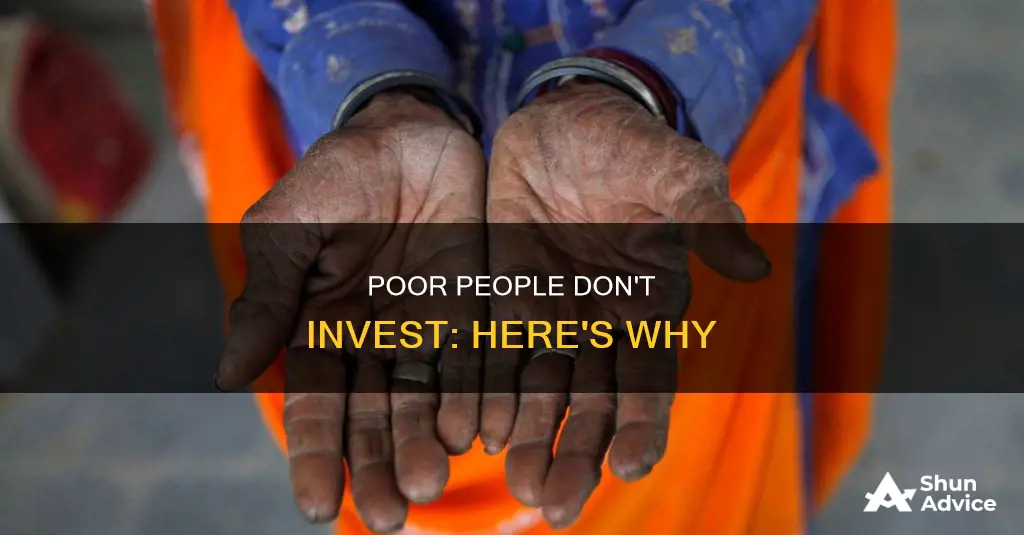
Poor people don't invest for a variety of reasons. Firstly, they may not have enough money to invest, as they are often living paycheck to paycheck. Secondly, they may be risk-averse due to their financial situation, and therefore avoid investing in riskier assets such as stocks. Poor people are also more likely to have meagre savings and may need to use their retirement accounts as emergency funds, making risky investments unsuitable. Additionally, they may lack financial knowledge or receive poor financial advice, leading them to make suboptimal investment decisions. Furthermore, systemic factors such as low-interest rates on savings accounts can disincentivise saving and investing for the future.
| Characteristics | Values |
|---|---|
| Lack of capital | Poor people have less money to invest |
| Lack of liquidity | Poor people need to keep their money in savings accounts to cover emergencies |
| Lack of access to financial education | Poor people may not know how to invest |
| Lack of trust in the economy | Poor people are reluctant to invest due to fear of losing money |
| Lack of diversification | Poor people tend to invest in low-risk, low-return assets |
| Lack of time | Poor people often work multiple jobs, leaving little time to research investments |
What You'll Learn

Poor people may not have enough money to invest
The advice often given to wealthy individuals is to invest their money, while those living in poverty are advised to save. However, saving accounts often offer extremely low-interest rates, which can be as low as 0.01%. This means that the purchasing power of their savings decreases over time due to inflation, which was 1.77% in 2014. As a result, individuals living in poverty may feel discouraged and disincentivized to save.
Furthermore, low-income individuals often do not have access to the stock market or other investment opportunities. They may also lack the financial knowledge or guidance to make informed investment decisions. This can lead to a fear of taking risks, as they are focused on finding safe havens for their money. However, taking calculated risks is an important aspect of investing successfully.
Additionally, low-income individuals who do invest may be encouraged to take on more risk to make up for their lower asset base. While this strategy can potentially lead to higher returns, it also increases the chances of significant losses. This approach may not be suitable for those who cannot afford to lose money, as they may need their savings as an emergency fund.
Overall, the lack of financial resources, access to investment opportunities, and financial knowledge can all contribute to the challenge of investing for individuals living in poverty.
Investments: Where People Put Their Money Now
You may want to see also

Poor people may not have the financial literacy to invest
Financial literacy is a crucial aspect of investing, and a lack of understanding about investment options and strategies can be a significant barrier for poor people. They may not have access to the same educational resources and financial advice as those with higher incomes, which puts them at a disadvantage when it comes to making informed investment decisions.
For instance, poor people may not understand the concept of risk management, which is essential for successful investing. They may be averse to taking risks, opting for safe havens and sure deals that offer low returns. In contrast, rich people often seek out risks and take calculated chances, knowing that these can lead to higher returns. Poor people may also lack knowledge about structural, legal, or market protections that can help them manage risk effectively.
Additionally, poor people may not have the financial literacy to differentiate between buying companies and buying stock. They may be drawn to the hype and sizzle of a high stock price without considering the company's long-term potential. This can result in poor investment decisions that do not maximize their returns.
Another aspect of financial literacy that poor people may lack is the understanding of diversification. While diversification can be a sound strategy in some cases, rich people know that focusing on growth through calculated risks can be more effective in increasing the value of their investments. Poor people may not have the knowledge or expertise to make these nuanced decisions and may miss out on opportunities for higher returns.
Furthermore, poor people may not fully grasp the concept of opportunity cost when it comes to investing. They may not realize that even if their investments are performing well, they could be doing better by allocating their funds differently. Rich people, on the other hand, constantly monitor their investments and are willing to make changes to maximize their returns.
Lastly, poor people may not have the financial literacy to understand the importance of making their money work for them. They may be content with saving their money in a bank account, unaware that inflation can erode its value over time. Rich people, on the other hand, understand that investing their money can help them stay ahead of inflation and grow their wealth.
Dollar General: A Smart Investment Move?
You may want to see also

Poor people may not have the time to invest
Additionally, those living in poverty often face more immediate financial concerns, such as paying rent, buying groceries, or covering medical expenses. This leaves little room for long-term financial planning or investing. Poor people may also have limited access to financial education and resources, making it more challenging to navigate the complex world of investing.
The time and energy required to manage investments can be a significant barrier for poor people. They may lack the necessary time to actively manage their investments, monitor the market, or make timely decisions. This can put them at a disadvantage compared to those with more financial stability and resources.
Furthermore, poor people often have irregular and unpredictable incomes, making it challenging to set aside a consistent amount for investing. They may also face higher transaction costs and fees relative to their investment size, further reducing their potential returns.
The lack of time and financial stability faced by poor people creates a cycle that can be difficult to break. Without the time and resources to invest, they miss out on potential gains and opportunities to build wealth. This, in turn, perpetuates their financial situation, making it even more challenging to find the time and money to invest.
Celebs Who Invested with Bernie Madoff
You may want to see also

Poor people may not have the opportunity to invest
Financial literacy is a crucial aspect of investing. Poor people often lack access to financial education and may not have the knowledge or skills needed to make informed investment decisions. They may also face information overload, with conflicting advice from various sources, making it challenging to discern reliable information.
Access to financial services is another critical factor. Poor people are less likely to have bank accounts or established relationships with financial institutions, limiting their ability to invest through traditional channels. They may also have negative experiences with the financial system, such as high fees or predatory lending practices, which deter them from engaging with financial services.
Additionally, systemic barriers play a significant role in preventing poor people from investing. This includes factors such as low wages, unstable employment, and limited access to social safety nets. Poor people often live paycheck to paycheck, with little to no disposable income left for investing. They may also have pressing financial obligations, such as debt repayment or unexpected expenses, leaving them with insufficient funds to invest.
The opportunity to invest is further diminished by the lack of incentives for saving. With low-interest rates on savings accounts, poor people find it challenging to accumulate substantial savings that could be channelled into investments. The disparity in investment advice also affects poor people, as they often receive generic or risk-averse recommendations that may not align with their financial goals or potential for higher returns.
Finally, poor people may face psychological barriers to investing. Fear of loss, anxiety about the stock market, and a preference for safe havens contribute to their reluctance to take on investment risks. These factors collectively reduce the opportunity for poor people to invest and improve their financial situation.
Investments: Where Does the Money Go?
You may want to see also

Poor people may not trust the stock market
The stock market is often touted as a sure-fire way to make money, but this is not always the case. The stock market can be volatile, and there is always the risk of losing money. For poor people, who may not have a financial cushion to fall back on, this can be a scary prospect.
Additionally, the stock market often favours those who already have money. For example, people with higher incomes are more likely to invest in the stock market than lower-income earners. This is partly because they can afford to take the risk, but also because they may have more knowledge about how the market works and feel more comfortable putting their money in it.
Poor people, on the other hand, often lack financial literacy and may not understand how the stock market works or how to invest wisely. They may also have negative associations with the stock market due to past crashes or scandals.
Furthermore, poor people often have different financial priorities than those with higher incomes. They may be focused on simply making ends meet and putting food on the table, rather than investing for the future. They may also have more immediate financial concerns, such as paying off debt or saving for an emergency fund, which take precedence over investing in the stock market.
Finally, poor people often face systemic barriers to investing in the stock market. For example, they may not have access to the same financial resources and opportunities as those with higher incomes. They may also face discrimination or bias when trying to invest, which can further discourage them from participating in the stock market.
All of these factors can contribute to poor people's distrust of the stock market and their reluctance to invest.
Movie Investors: Who Are They?
You may want to see also
Frequently asked questions
Poor people often don't have enough money to invest. They may also be wary of the risks involved in investing.
Investing can be risky because there is a chance of losing some or all of the money invested. Poor people often cannot afford to lose money and therefore avoid risky investments.
Yes, rich people know that risk can be managed. They take calculated risks and look for structural, legal, or market protections.
Poor people may not have access to the stock market or other investment opportunities. They may also lack financial education and feel unsure about how to invest.
Poor people can start by educating themselves about investing and seeking out low-risk investment opportunities. They can also focus on building an emergency fund and saving for retirement.







